Winter 2005
To keep you updated, the Department
is publishing a summer and winter electronic newsletter. The
spring and fall printed issues will continue to be posted on
our website:
www.entm.purdue.edu/entomology/news/alumni.html
TABLE OF CONTENTS
Feature Article:
Notes
on Invasive Species from an Invasive Kind of Guy
Department News
From the Head Bug:
Research
Outlook for Entomology
Outreach Update
Development Update
Entomology Students
Alumni News
Calendar
FEATURE ARTICLE
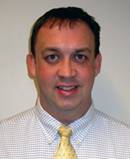
Christopher M. F. Pierce
Notes on Invasive Species from
an Invasive Kind of Guy
As an invasive species
myself (an Illini in The Land of Purdue), I am well aware of the
problems that invasive species present. [Full Article]
Chris is the State Survey Coordinator for Indiana CAPS (Cooperative Agricultural
Pest Survey).
DEPARTMENT NEWS
Outstanding Service Award
2004
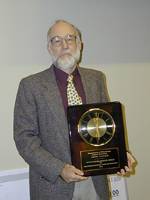
Larry Bledsoe (MS ’81) receives the 2004 Outstanding Service
Award. [More
Photos] The award is designed to honor performance,
contributions, and accomplishments and to recognize continued
outstanding service in the department. Larry, a Field Crops
Pest Management Research/Extension Entomologist, is responsible
for converting field and forage crop research findings into educational
products and to deliver them to the public and private agricultural
industries. He is recognized as a leading authority on
corn and soybean production in the Midwest and serves on numerous
committees, projecting a positive and professional image of the
department. Larry always goes out of his way to be helpful,
has a strong work ethic, and is dedicated to his job and the
department.
Following the OSA award presentation
to Larry, the department enjoyed a buffet lunch at the Awards
and Holiday Reception. The presentation and reception
were held in the Pfendler Hall Auditorium and Gallery. [See
Photos]
NEW STAFF
Christian H. Krupke , PhD, has accepted the position of Assistant Professor
in Field Crops Entomology at Purdue University, West Lafayette,
Indiana effective January 18, 2005. Christian completed his undergraduate
degree in Biological Sciences at the University of Guelph, Canada
in 1995. He then received a Masters degree with an emphasis in
pest management from Simon Fraser University in 1999. Christian
completed his Ph.D. with Jay Brunner of Washington State University
in 2004. His dissertation research focused on the pheromone
response and mating behavior, one of the main pest species in
the area, the consperse stink bug. Christian’s
dissertation addressed basic questions about the proximate and
ultimate functions of aggregation formation in this species,
as well as the role of mate choice in the insect’s mating
system.
Scott Charlesworth started December 2004 as Building Deputy and Technical
Assistant in Whistler. Scott, a native of Lafayette,
specializes in computer graphics.
John Walker joined the CERIS team in December 2004 as a Programmer/Analyst
on the NAPIS project. He previously worked for Universal
Music Group in Fishers, Indiana.
Preston Wiley joined the CERIS team in December 2004 as the Network
Services Specialist. Preston came from Fairnet LLC in Monticello,
Indiana.
Ryan Selby , the department's new Business Office Manager, began
his position in January 2005. Ryan is a Krannert graduate
and comes from Crowe Chizek and Company.
DEPARTING STAFF
Kelli Knoth , Main Office Secretary, joined the business office
in the College of Liberal Arts.
Nikki Kubly , Business Office Manager, has taken a position with
an accounting firm in Indianapolis.
Congratulations to John Obermeyer and Cliff
Sadof who were recognized in October with two prestigious
awards for their service in Extension. John received the PUCESA
Senior Award for his IPM communication and training efforts,
and Cliff Sadof received the Sharvelle award for his pest management
work on ornamentals and landscape pests for the general public
and the nursery industry. Way to go John and Cliff! [Photos and full story]
The 2004 John V. Osmun
Award in Entomology was presented to David
B. Hogg (MS ’73) on October 15th. David’s
seminar, “Malcom in the Middle” - The Niche for
Academic Departments of Entomology, and the award presentation
were held in the recently renovated Pfendler Hall. [Photos] Nominations
for the 2005 Osmun Award are currently being accepted. Please
go to our website to submit a 2005
Nomination Form. Nominations
are due June 1, 2005.
FROM THE HEAD BUG
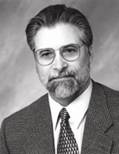
Steve
Yaninek
Research Outlook
for Entomology
There are many ways
to look at the future. Albert Einstein was philosophical when
he observed “I
never think of the future - it comes soon enough.” Leave
it to Yogi Berra to ponder the future by looking in the past
- “the future ain't what it used to be.” Universities
are more likely to agree with Franklin Delano Roosevelt who said “we
cannot always build the future for our youth, but we can build
our youth for the future.”
In many respects, entomology
research is evolving today to meet tomorrow’s challenges.
While it is impossible to know the future with certainty, we
can be deliberate about the paths we choose. To this end I offer
a few opinions about the directions in research I believe entomology,
as a discipline and academic departments such as ours, is likely
to pursue in the future.
Entomology has a bigger
and more diverse research portfolio than ever before. We continue
to benefit from traditional pest management programs such as
those supported by USDA at the federal level and various state
programs, but the real growth in recent years has been in the
basic life sciences and in public health.
Entomologists today
work in just about every field in the life sciences. Insects
such as Drosophila, honey bees, mosquitoes, and other invertebrates often associated
with entomology as well as nematodes and mite vectors are important
biological models in the life science community. Entomologists
are engaging these insect models along with their traditional
pest management responsibilities in a new research paradigm.
The result is a research portfolio that is much broader biologically,
more basic, more diverse, interdisciplinary, and better funded.
The Council of Entomology
Department Administrators (CEDA), a group of entomology department
heads and chairs from mostly land grant universities and the
USDA Cooperative State Research, Education, and Extension Service,
recently took stock of the current trends and directions in research
priorities across the country and come up with broad areas where
entomologists are likely to be involved in the next five years.
They identified the following eight areas (in no particular order)
as targets and priorities:
Bio-based Products
Environmental
Stewardship
Genomics
Homeland Security
Human and Animal
Health
Invasive Species
Safe and Sustainability
Food Supply
Science Literacy
Additional details
about each initiative can be found on the CEDA
website.
These topics reflect many of the research priorities in the life
science community and are central to the evolving research mission
in the land grant universities. The real news for entomology
is that our research portfolios are broadening beyond the traditional
pest management research base with more fundamental science,
and new attention to emerging areas of broad national interests
e.g. homeland security.
At Purdue, our research
portfolio is certainly moving in this direction. We work on molecular and cellular biology, physiology
and biochemistry, toxicology, genetics, behavior, nematology,
ecology, aquatic biology, systematics, insect pest management,
host plant resistance, biological control, and functional biodiversity. This includes basic research in support of our traditional pest
management mission, as well as contributions that address fundamental
questions in the life sciences. Our
research portfolio can be broadly divided into six signature
areas based on acknowledged expertise and emerging opportunities
as follows:
Genomics and Proteomics
Urban Pest Management
Crops and Livestock Pest
Management
Environmental Stewardship
International Development
Science Education
More information about
our research in each of these areas can be found at the following
website:
www.entm.purdue.edu/research
Some examples of our current R&D
efforts include molecular research focused on the search for
avirulence genes in Hessian flies, evaluating the mechanism of
resistance to soybean cyst nematodes, identifying specific target
sites to improve pesticide resistance management, determining
the genetic basis of honey bee and mosquito behaviors, characterizing
the digestive inhibitors in cowpea weevils, and sequencing the
first tick genome.
We’ll add new molecular skills
to our urban program as soon as the recently established O. Wayne
Rollins/Orkin chair in urban entomology is fully endowed. In
the meantime, we’ve increased our research capacity in
urban pest management with the addition of a new insect ecologist
working on multi-trophic level interactions in turf grass ecosystems.
Our environmental research has
increased in recent years with more attention given to invasive
species, and the addition of a new faculty member with skills
in spatial biology and interest in biodiversity to augment our
efforts in aquatic biology and mayfly systematics. We hope to
add expertise in the area of invasive species and increase our
capacity to develop new tools to rapidly detect and efficiently
monitor both accidental and deliberate pest introductions.
Our extension programs continue
to benefit from a strong applied research agenda that varies
in depth and scope depending on the nature of the problem and
the needs of the clientele group. For example, a new interdisciplinary
team of faculty has been hired to develop a state-of-the-art
field crops program. Our new field crops entomologist who joined
the Department in January is part of this team.
Many of our research programs have
corresponding international components. A good example is the
Network for the Genetic Improvement of Cowpeas in Africa (NGICA).
This is a network of volunteer scientists and stakeholders interested
in improving cowpea production. A central tenant of NGICA is
to foster the application of biotechnology tools in traditional
plant breeding and selection. Leadership for this effort is provided
by one of our faculty.
Our research is invariably
reflected in the courses and curriculum we offer to our students.
This part of our mission continues to evolve as we strive to
provide our students the proper balance between core fundamentals
and cutting edge knowledge. Students receive instruction from
award winning teachers following a contemporary curriculum designed
to provide the tools needed to be successful in today’s
world. We’re also encouraging undergraduate research as
a way to promote the next generation of scientists.
Changes and new programs
in our research portfolio require new resources. To this end,
the department invests in priorities outlined in our strategic
plan. This is being achieved in part with strategic investments
from the University and new extramural support. We’re also
raising faculty endowments to attract world-class scholars to
join our team. Regarding new facilities, we’re building
a new insectary for mosquito research, raising money for a quarantine/containment
facility, and a future outreach center.
Research in the life
sciences continues to evolve and change, and Entomology at Purdue
is riding the wave. Our research portfolio is expanding beyond
the traditional pest management mission with more basic science
and a strong interdisciplinary flavor. Contributing to interdisciplinary
efforts from a strong disciplinary base such as entomology remains
the best formula for successful and productive collaboration.
While most of the expansion in our research portfolio will be
funded by federal programs, support from the state and industry
for local programs and targeted activities will continue to be
critical. Ultimately, our research efforts will only be as relevant
as the questions we address and the clientele we serve. To this
end, we’ve adopted a strategic plan that is as dynamic
and flexible as the times we live in.
~ Steve Yaninek ~
OUTREACH UPDATE
Entomology Career Development
In January the Entomology Department
and the Indiana State 4-H Department at Purdue hosted the State
Entomology Career Development Event. Forty-two junior division
and 125 senior division students representing 19 schools from
around the state of Indiana tested their taxonomic knowledge
and insect identification skills. Participants passed Riker
mounts that contained questions and insects for identification.
HASTI Convention
Members from the department participated
in the 35th annual Hoosier Association of Science Teachers Conference
in Indianapolis. By hosting sessions and talking with secondary
school teachers department members promoted the use of insects
in the advancement, stimulation, and improvement of science education
in Indiana. Insect sessions and displays conveyed information
on how to engage students in the inquiry process. CAPS Coordinator
Chris Pierce gave a presentation on Invasive Species in Indiana
- An Update. Outreach Coordinator, Mike Mullis captivated
convention goers with the departments tractor pulling cockroaches.
The 15th annual Bug
Bowl is scheduled for April 16th and 17th. With
nearly 40,000 people in attendance during the Purdue Spring
Fest Weekend it is the largest known insect-themed event
of its kind.
DEVELOPMENT UPDATE
It is an exciting time to be at
Purdue. The University is moving forward on an aggressive campaign
to achieve pre-eminence and the Department of Entomology is fully
engaged in the effort. We’re excited about the generous
gift we recently received from the O. Wayne Rollins Foundation
to endow the O. Wayne Rollins/Orkin Chair in Urban Entomology.
This endowment will add a dedicated
faculty program with modern molecular capabilities to bear on
urban pests that complement our current R&D efforts. We’re
also grateful for the generous support we’ve received over
the years from the many friends of Entomology at Purdue for a
wide range of collaborative activities, scholarships, and other
endowments that have been critical to our success.
Receiving two endowed chairs in
one year is quite remarkable, but it doesn’t pay the bills
for our student-based activities. This past year the Department
dispersed $45,700 from endowments and direct checks to support
31 awards for 28 student scholarships, but there are a number
of development challenges that still remain. To be a leader in
entomology, we’ve established the following development
priorities to address our most critical needs:
- $20,000 to renovate our student
resource room to accommodate our rapidly growing undergraduate
population which doubled in the past two years,
- $25,000 a year in new scholarships
and other endowment support to recruit the top students, promote
undergraduate research, and provide travel support for student
participation in professional development activities,
- $1.5 million to endow a faculty
enhancement fund in the name of the venerable John V. Osmun
in recognition of his 60 plus years of service to the university,
Success will depend on strong backing
from alumni, friends, and industry. We look forward to
your continued support.
ENTOMOLOGY STUDENTS
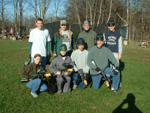
Paintball -Students take time out for recreational
activity. [More Photos]
AWARDS
Walter Baldauff received approval for $500 of undergraduate research
funding. Walter will be working with Doug Richmond on nitrogen
fertility and endophyte-enhanced resistance.
Students win top awards for their
presentations at the Ohio Valley Entomology Association meeting
held October 29th in Hanover, Indiana. The meeting
was held in parallel with the Indiana Academy of Science’s
annual meeting.
Rianna Arcinas |
2nd Place for Undergraduate
Presentation |
Justin Vitullo |
3rd Place for Masters Presentation |
Shujuan Li |
3rd Place for PhD Presentation |
OUTSTANDING STUDENT AWARDS
The following students have been
chosen for the department’s Outstanding Student Awards. The
winners of these awards are automatically nominated for the College
of Agriculture’s Outstanding Student Awards.
Kristi Jukovich -
Freshman
Nick Seiter -
Sophomore
Tyler Janovitz -
Junior
NEW UNDERGRADUATE STUDENT
Emily Shebish is a codo student
from Animal Science and has a degree from Purdue in Liberal Arts.
NEW GRADUATE STUDENT
Yaritza Charneco, from the University
of Puerto Rico/Aguadilla, is in the MS Program with Barry Pittendrigh.
NEW POSTDOC
Kurt Saltzman (PhD ’04) started his Postdoc position in January. Kurt
is working with Christy Williams.
DECEMBER GRADUATES
Amber Burton, BS
Victoria Fickle, BS
Kristian Leveridge, BS
Craig Roubos, MS
Justin Vitullo, MS
Kurt Saltzman, PhD

Michael Meyer
In the Middle
It began when I earned
my first teaching position. I had just graduated from the
University of California, Davis credential program and was given
a classroom full of thirty-three rambunctious sixth graders. I
was hired to work with a “bubble” class, an unusually
large group of students for a particular grade level, filling a
space that would last until graduation. My peers had children
of their own, and we (my future wife, Rosalee, and I) were in the
beginning stages of considering kiddos. As the youngest member
of the staff, I was in the middle, somewhere between my coworkers
and students. Six years later, I found myself enjoying the
life of an elementary instructor, but missed being actively engaged
in science, and being surrounded by peers with similar interests. While
relaxing after a morning of chasing birds in Southeast Arizona,
I decided to pursue a graduate degree. The following year
found me in the middle, being in one place while trying to get
to another. With a few offers on the table, I, along with
my wife and then two-year-old son Christopher, chose the Department
of Entomology at Purdue University. We said, “See you
soon!” to our friends and family, then hit the road. After
driving for a week across the county during the summer’s
most intense heat wave, we arrived safe, and I quickly became part
of the department’s Aquatic Entomology Lab. I had experienced
more of the “real world” than most of my fellow graduate
students, and was nearly the age of many faculty members within
the department. I found myself somewhere in the middle, a
professional with a history, yet starting a new career as a student. Six
years later, with a second son, Asher, as part of the family, my
schooling is nearing its end. I again find myself in a peculiar
situation. I have spent time and energy working on and sending
off job applications, with a huge dissertation waiting to materialize. I
find myself almost done, yet far from it, while eagerly anticipating
employment opportunities. To date, I’ve had one phone
interview, and have been called back for a site visit from the
same institution. The entire family is on an emotional rollercoaster,
a wild and exciting ride where we have little control. What
does the future hold? Time will tell. Until then, I
can be found in the basement of Smith Hall, somewhere in the middle.
~ Michael Meyer ~
ALUMNI NEWS
Robert N. Wiedenmann (PhD ’90) has accepted a position as the head
of the Department of Entomology at the University of Arkansas
beginning March 2005. Rob is currently the Director of
the Center for Ecological Entomology at the Illinois Natural
History.
Beth Grafton-Cardwell (MS ‘80) received the Citrus Research Board’s
Award of Excellence 2004 for exceptional service to the California
citrus industry.
Dr. Phillip E. Sloderbeck (MS ’77) received the Distinguished Service Award
to the ESA Certification Program for outstanding contributions
to the ESA Certification Program and the professionalism of entomology.
Phillip is an area extension specialist with Kansas State University.
Dr. Rick Brandenburg (BS ‘77) received the Recognition Award in Urban
Entomology, sponsored by S.C. Johnson & Son. Rick is a professor
of entomology and the co-director of the Center for Turfgrass
Environmental Research and Education at North Carolina State
University.
Tianqi Wang (MS ‘96)
recently sent us this update. “After graduation from Purdue
I was invited to work with Dr. Robert Sites and lead a state
wide aquatic insects project at the University of Missouri-Columbia.
In 1998, owing to family reasons, I moved to Greenville, South
Carolina. In a big move to catch the internet opportunity and
new economy, I decided to apply my knowledge learned in Systematic
Entomology and other academic areas under the directions of Dr.
Pat McCafferty and other Faculties in Purdue, and started with
a broad knowledge based internet portal business, called HouseCenter.Com.
The challenges and opportunities drove me further to the peak
as internet consultant, stock trading consultant, pest control
consultant, Feng Shui consultant, real estate consultant, and
business development consultant. I established a real estate
brokerage company in Boston called House Center - TQ Realty,
and an investment holding company House Center Inc. I never forgot
what I heard from our graduation: It is not only what we learned
today that would work for us, but it is Purdue Spirit that would
carry us to broad success. Hi! to all folks - past and present-
in the department.”
Jolene Hurt (BS ‘04) sent in photos (below) of her recent
world travels. She is saddened by the devastation of Ko Phi Phi,
Thailand where hundreds of people were killed and the town completely
destroyed by the tsunamis. Jolene will be an entomology intern
at Hawaii Volcanoes National Park starting in February. Her internship
is with the US Geological Survey’s Palila Restoration research
project.
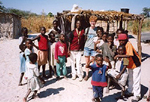 |
 |
Namibia |
Angkor,
Cambodia |
| |
|
 |
 |
Santorini,
Greece |
Ko Phi
Phi, Thailand |
Stoy A. Hedges (BS ’81) currently serves as Manager of Technical
Services for Terminix International based in Memphis, Tennessee.
His most recent accomplishment was serving as the Editorial Director
for the Mallis Handbook of Pest Control 8th and
9th Editions, which was published in February 2004.
Stoy has authored five field guide books, is currently working
on one for cockroaches with plans for four more for the series,
and has more than 140 articles for PCT Magazine. PCT Magazine
awarded Stoy as Professional of the Year and published
a compilation of 50 of his best articles in the book ANThology:
The Best of Stoy Hedges. In addition to many other honors
and recognitions, Stoy has made 19 consecutive presentations
at the Purdue Pest Control Conference.
Timothy Johnson (PhD ’84) “After graduating
from Purdue, I accepted a position of Research Scientist with Ecogen
Inc. in Langhorne, PA. Ecogen was one of many agriculture biotech
start-ups formed in the 1980’s. Joining a new company at
its birth was both exhilarating and occasionally terrifying. In
17 years at Ecogen, I served in a variety of positions from managing
the discovery of biological pesticides through their development
and ultimately into marketing. Probably my most notable achievement
was serving as a Project Leader with several other Ecogen scientists
in the discovery of a Bacillus thuringiensis isolate that
produces a protein toxic to corn rootworm larvae. This discovery
resulted in a patent and, after additional protein engineering
and mutagenesis work by other Ecogen scientists, is the basis
for Monsanto’s YieldgardÒ corn rootworm resistance
technology recently released into the hybrid corn marketplace.
In 2001 I joined Plato Industries, Ltd. located in Houston, Texas. At
Plato Industries I am responsible for our business of providing
boll weevil monitoring supplies to state boll weevil eradication
programs and new product development. In the past year I have
filed patents for a new grandlure pheromone dispenser for use
in boll weevil monitoring and for a new trap design for monitoring
adult Lepidoptera. Both products will be launched during 2005.
On a personal level, I have been
married for 27 years to my wife Mary who works as a Certified
Diabetes Educator at an endocrinology practice. Mary and I have
two grown daughters, one who is a marine science technician at
the Virginia Institute for Marine Science and a second who is
presently working with a NGO in Belgrade, Serbia trying to keep
people from killing each other. For those who know me I still
fish (a lot) and a few years ago Mary decided to try entering
triathlons. The triathlon venture has been quite a trip culminating
with Mary qualifying for and competing in the World Triathlon
Championship in Kona, Hawii this past October.”

Mary’s 1st place age group finish at Ironman Wisconsin
(L-R)
Dana Johnson (daughter), Tim Johnson, Mary Johnson, two of Mary’s
nieces
Franklin Laemmlen (MS ’66) will retire
in July after 35 years in Cooperative Extension. Franklin is currently
the County Director and Farm Advisor – Vegetable Crops/Pest
Management at the University of California, Santa Barbara/San Luis
Obispo Counties, California. Franklin joined the University
of California in 1980 as a Farm \Advisor in Plant Pathology/Nemotology.
His career began at Purdue University as Extension Assistant in
the Department of Entomology. Franklin has also served as
Science Master at a girls’ school in Kenya, East Africa,
and Associate Professor/Extension Specialist at Michigan State
University.
Bruce Lube (BS ‘72) teaches Microbiology at Stanly Community
College in Albemarle, NC. Bruce has great memories of playing
basketball with Tom Turpin and Gary Finni, followed by pizza
and beer at Bruno’s. He and Bernie Huff still get together
once a year with Ron DeHollander, a friend of Al York’s.
Kevin A. Shufran (BS ‘82) of Stillwater, Oklahoma
sent in this update. “I can’t believe it has been 23
years since I left Ye Olde Entomology Hall! I am a Category 1 Research
Entomologist with the USDA-ARS in Stillwater, OK. In 2004 I was
promoted to GS-13. I have had the honor of becoming a Fellow in
the Royal Entomological Society of London. Currently I am chair
of the WCC-66 Coordinating Committee on Russian wheat aphid and
other cereal aphids and serve as a grant panel chair for CSREES.
I also am Adjunct Assistant Professor at Oklahoma State University.
Basically I earn my keep by being the aphid geneticist, but also
conduct some research in biological control. The main focus
of my research program is aphid evolution/adaptation to resistant
cultivars. This means getting at the truth behind the biotype
myth and moving the field of plant resistance beyond the simplistic
model that plant resistance genes act in an analogous fashion
as pesticide selection, thus causing the occurrence of virulent “biotypes”.
Having received my PhD at Kansas State University, this is something
like heresy but none of the late Dr. Reginald Painter’s
students (e.g. Prof. Eldon Ortman) have put me on the rack and
forced to me to renounce! Tally Ho!”
|
|
Himalayan Tahr |
On the Hoopehorn |
Robert Dolphin (BS ’65) has fond memories of Purdue
and working out the ecological life history of the sweatbee, Halictus
confuses, under the guidance of Dr. Leland Chandler and the
leadership of Dr. John Osman while assisting Dr. George Gould
in his research. He is presently a naturalist with broad interests
in the natural sciences, including entomology. A runner since
1981, Robert ran his 350th marathon in 2004.
At age 75 he runs about 20 marathons per year in the 4:30+ range.
Go Robert!
CALENDAR
| February 12 |
Purdue Ag Fish Fry, Indianapolis State Fairgrounds |
| March 20-23 |
ESA NCB Meeting, Purdue University |
| April 16-17 |
Spring Fest - Bug Bowl |
|